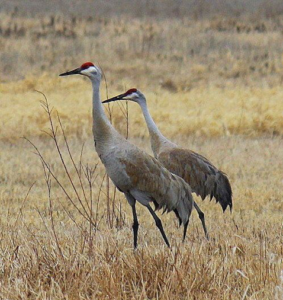Sandhill Cranes
– By Mike Hanson
My father taught me to identify birds by their song but I never heard The Greater Sandhill Crane while I was a snippet, did you? Never saw one either and you would think I would remember as their size stands out, they are about 4 feet tall and have a wingspan of up to 7 feet and can weigh up to 14 pounds. At one time the Cranes were common across much of Minnesota but were decimated by market and subsistence hunters during the 1880’s and shot at every opportunity from spring to fall. By the 1940’s no more than 40 to 50 remained in Minnesota, the Duxby bog near Roseau was their summer retreat.
This spring I have been watching them cavort while listening to their seemingly extemporaneous vocal inflections. Their call hails spring in the North, it cogitates ideas about ice out, garden adventures and makes even the grizzled pessimist think warmer temperatures are ahead. Their call is loud, roiling and sounds like a rolled throaty eastern accented Capital “R”, in actuality the tone is a product of anatomy, they have long tracheas that coil into the sternum and helps develop the incredible harmonics. Sandhills have elegant and captivating dancing skills even if a bit gangly, courting Cranes stretch their wings, pump their heads, bow and leap into the air, similar to the dancing of today’s young folks, maybe proof that Rock and Roll still lives.
Cranes have seen cataclysmic events, fossils have been found dating back almost 10 million years and they appear to have changed little. They mate for life a span of 20 to 40 years and although some start breeding at two years of age they may reach the age of seven before conjugal nesting. They build their nests from the dominant vegetation such as cattails, sedges, dried plant material early in the spring and add green materials later. To the foundation of larger material they add a cup shaped hollow that is lined with small stems and twigs, both gather material but it is the female who usually arranges the material. Nests may be 30 to 40 inches across and 4 to 6 inches high, those built over water are larger than those built on dry land. The hatchlings are expedient, Crane populations grow slowly because each breeding pair usually has only one chick per year that survives to fledging. Juveniles stick close by their parents for 9 or 10 months and amazingly chicks can leave the nest within 8 hours of hatching and are even capable of swimming. Cranes feed on land or in shallow marshes, their diet is heavy in seeds and cultivated grains, in fact as Crane populations increased farmers voiced their concerns about crop depredation especially in the Spring when newly planted corn sprouts were plucked from the ground eating the planted seed. The International Crane Foundation is in Baraboo, Wisconsin and they have worked to develop a repellent to treat seed corn, it is non-lethal and an active ingredient that makes the corn distasteful, they learn to avoid it. A varied diet also includes dining on berries, tubers, snails, snakes, amphibians and the like.
The residents have expanded from the Duxby bog now showing an average of 5,000 in the northwest and the Minnesota population now appears to exceed 15,000. Cranes are naturally preyed upon by fox, raccoons, coyotes, wolves other critters and aerial predators, they are not stoic when confronted, they attack the aerial predators by leaping into the air and kicking their feet forward and greet the terrestrial hunters by spreading their wings and hissing eventually resorting to kicking.
Cranes are known for flying at great heights and Chinese legend considered them to be messengers of the gods who carried souls of the dead to paradise, indeed The Greater Sandhill Cranes have been documented flying at 8,000 feet.

